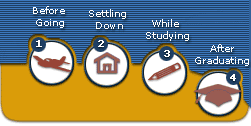 |
 |
 |
 |
 |
 |
 |
| Privacy Policy |
| Disclaimer |
| Terms & Conditions |
|
Health Care and Culture
Andrew: What percentage of international students coming to you have some difficulty with language? Jean: Probably 95% of them have difficulty, but as time goes on, and they become more familiar with English, that percentage drops down. But initially [they have trouble]-partly because they are ill and not working at top efficiency, and if you've got a high fever, you can't even [speak well in your native labguage]. I can't even understand English when I'm sick! So it's doubly hard for students when first of all they are ill, and second have to [work] in a language that is not as familiar to them as their own language. Lu: One of the things that I want to add in there is that hopefully you would have a health service that would be sensitive to the needs of time involvement in an appointment. I know that our people are really good when they make appointments for me, and if they know it's an international student, they will allot me more time, so that the patient doesn't feel rushed. The worst thing is the student being turned off by the fact that they were rushed through an appointment. It's good to be able to sit with them and develop a confidence level by treating them gently and slowly. I know that there are times when I will end up taking an inordinate amount of time just to make sure that all of our instructions [are] written and understood so that we are communicating efficiently. Knowing that they are not the only one with language difficulties is so good. They might also be preferential about who they see, and that's OK. They can pick a favorite; they don't just have to see anybody.
Andrew: What else can international students do to bridge the language gap? Lu: At a smaller university they'll probably have more access to health than they will at a larger university. It's easier to navigate because everybody knows everybody. If you go to a campus like the University of Washington, which is large and should have all these health aids accessible to them, sometimes it's more difficult. Jean: One of the things connected with our campus is the American Cultural Exchange (A.C.E.) Language Institute (A.L.I.), which oversees the English as a Second Language (ESL) program. They will actually guide students through much of this cultural stuff prior to their becoming mainstream students. What they have done-and we've tried to mimic this-is that when a student is going somewhere, they send someone with them who knows more than the student does. They can talk back and forth in their native language and then speak it in English because sometimes two minds working together can takes some of the fear out of asking questions and getting the information straight. So, it is helpful going on the "buddy system," and even going into a health care situation, if they have somebody who knows more English than they do and yet can still communicate [in the patient's native language], it's very helpful. What we might say with one word, and we hit a blank wall, it might help that second person to say, "Oh, yeah, but what about . . ." It just works very well. It gives them also an advocate, and they're not quite as alone, taking out some of the fear so that they can assimilate the information-it works very well. Lu: One thing that we have to do as providers is to make sure that we don't address our questions to the translator, but to the student. A lot of times it's body language, and it's being attentive to the patient, not to the translator. My mother brought this up once, that because of a language difficulty, people used to address me and not her, and that really ticked her off a lot. I've tried to be aware of that when I'm dealing with a student and taking care of a student who, even if I know that they don't understand me, I speak directly to them. And sometimes, if they don't give me eye contact because of their culture, what I'll do is position myself in a way that I can see them and get their cues from their physical movement, but not make an imposition to them about their culture and how they would relate to me. So a lot of times it's having this cultural awareness so that I can not be aggressive or assertive and access information but still respect their place and the fact that they are the patient.
Andrew: Are there ways that international students can prepare themselves to accept certain tests or procedures? Jean: It can't always be done on the first visit. We have to build a rapport and a trust with them with a lot of explanation-this scenario versus that scenario-trying to get them to look out for what is best for them. For instance, if you need to do a gyn (gynecological) exam, you may not be able to do that on the first visit. It may need a follow-up visit after they've had it explained to them what's going to happen and then being able to ask questions. Sometimes that doesn't even work. Lu: I use a lot of pictures and models with some patients. Some Hispanic women would have anal sex instead of vaginal sex because they'd still have their vaginal area intact and be virgins. That would bring a whole list of diseases that might accompany that. With some of my female Iranian patients I could not do a pelvic exam to determine whether they had a simple cyst so I could treat it. They would opt for us to say, "OK, I can order an ultrasound," which is $470 versus a simple in-office pelvic exam that would still allow me to treat them and determine what the issue was. So sometimes money is a really funny issue there as to what is acceptable to them culturally.
Andrew: Is there anything else you would like to add? Lu: Some of our students see the American frenetic way of life, and they tend to say, "yes, yes, yes" to everything and sometimes that's part of their cultures, saying "yes" with a smile and a bow. What we try to tell our students is don't over commit, and learn how to say "no." I don't know how to do that myself; I'm the poorest role model. But it's very important that they know that they have choices. Becoming acculturated means learning how to feel comfortable with the options that are offered. One thing that I forgot to mention here, and I used to do it at Bellevue Community College (BCC)-and I know that one of the instructors here does it too-is taking international students to one of our supermarkets and showing them how to shop and get through the system of that kind of store and showing them how to look at labels and to buy food so they don't end up with something strange and not nutritious if they happen to be living off campus. A lot of our international students do not live in the dorms and do live off campus. For these kids, we have to lead them by the hand for a while because their biggest stresses are "I don't know how" and the language difficulty. Jean: There is such a fear of asking questions or losing face or feeling like it's a stupid question to ask when in all reality the only stupid question is the one you didn't ask. They don't have that concept because if you have to ask for help, you're somehow less qualified and you shouldn't even be here, but the whole point of being here is to ask questions and to learn, but that's not always how they come into it. Hopefully, that's how they come out of it, but that doesn't always happen in the very beginning. Lu: One thing that I found helpful when I was at BCC was that one of our employees used to make sure that Japanese students, for instance, all had Japanese-English / English-Japanese dictionaries that when they came to the health center, if they had an issue they would look it up in Japanese and it would have the accompanying word in English next to it like "I have a sore stomach" or "I have a sore knee." It was really helpful, so oftentimes if I didn't have a translator available, this was a really good way of communicating. We are fortunate here that many of the international students have a faculty member or somebody that they know who will come and help provide translation. Again, something like that is helpful, not only a dictionary that can translate to and from their language. There are certain medical facilities in each community that have language banks or translators. Here, let's say a place like Harborview Medical Center, has paid language interpreters, and they have some who are on staff and who are there all the time, but [they usually can only translate] the languages that are most prevalent. But some of these institutions as well as some of these facilities have paid on staff, or access to, translators because it's very, very hard to help a student if you can't understand their language or what they're telling you.
Jean Brown, R.N., works as the Nurse Manager in Health Services at Seattle Pacific University. Luana V. Joslin, ARNP, works as a Family Nurse Practitioner in Health Services at Seattle Pacific University. Combined, they have 45 years of experience in the health care field. Both have extensive experience working with international students. |
 |
| ||||||||||||||||||||||||||||||
|
| ||||||||||||||||||||||||||||||
Home | About iStudentCity | Job Opportunities | Contact iStudentCity Hall
Copyright©2000-2009, iStudentCity.com. All Rights Reserved.
 iStudentCity editor Andrew Purvis spent an hour speaking with Seattle Pacific University nurses Jean Brown and Lu Joslin about health issues. Their comments were thoughtful and informative. We encourage every iStudentCitizen to read each of the four resulting articles carefully. A healthy student is a happy and productive student.
iStudentCity editor Andrew Purvis spent an hour speaking with Seattle Pacific University nurses Jean Brown and Lu Joslin about health issues. Their comments were thoughtful and informative. We encourage every iStudentCitizen to read each of the four resulting articles carefully. A healthy student is a happy and productive student.
